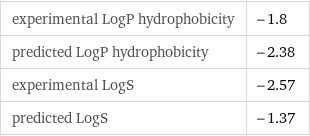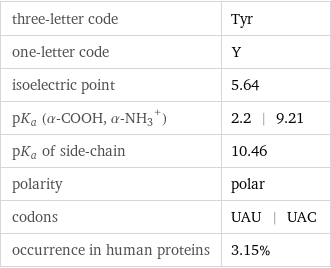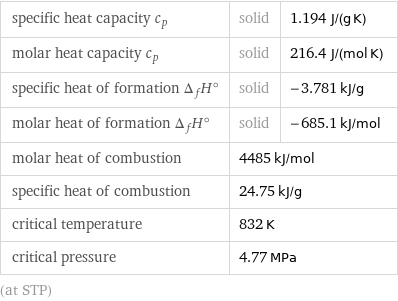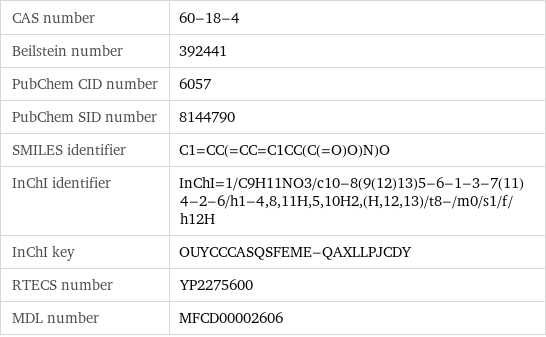Input interpretation

L-tyrosine
Chemical names and formulas

formula | (HO)C_6H_4CH_2CH(NH_2)CO_2H Hill formula | C_9H_11NO_3 name | L-tyrosine IUPAC name | (2S)-2-amino-3-(4-hydroxyphenyl)propanoic acid alternate names | (2S)-2-amino-3-(4-hydroxyphenyl)propanoic acid | 3-(4-hydroxyphenyl)-L-alanine | L-(-)-tyrosine | p-tyrosine | (S)-2-amino-3-(4-hydroxyphenyl)propionic acid mass fractions | C (carbon) 59.7% | H (hydrogen) 6.12% | N (nitrogen) 7.73% | O (oxygen) 26.5%
Lewis structure

Draw the Lewis structure of L-tyrosine. Start by drawing the overall structure of the molecule, ignoring potential double and triple bonds: Count the total valence electrons of the carbon (n_C, val = 4), hydrogen (n_H, val = 1), nitrogen (n_N, val = 5), and oxygen (n_O, val = 6) atoms: 9 n_C, val + 11 n_H, val + n_N, val + 3 n_O, val = 70 Calculate the number of electrons needed to completely fill the valence shells for carbon (n_C, full = 8), hydrogen (n_H, full = 2), nitrogen (n_N, full = 8), and oxygen (n_O, full = 8): 9 n_C, full + 11 n_H, full + n_N, full + 3 n_O, full = 126 Subtracting these two numbers shows that 126 - 70 = 56 bonding electrons are needed. Each bond has two electrons, so in addition to the 24 bonds already present in the diagram add 4 bonds. To minimize formal charge carbon wants 4 bonds and oxygen wants 2 bonds. Identify the atoms that want additional bonds and the number of electrons remaining on each atom: Fill in the 4 bonds by pairing electrons between adjacent highlighted atoms: Answer: | |
3D structure

3D structure
Basic properties

molar mass | 181.19 g/mol phase | solid (at STP) melting point | 300 °C boiling point | 351 °C density | 1.41 g/cm^3 solubility in water | very soluble
Units

Hydrophobicity and permeability properties

experimental LogP hydrophobicity | -1.8 predicted LogP hydrophobicity | -2.38 experimental LogS | -2.57 predicted LogS | -1.37
Basic drug properties

approval status | approved | nutraceutical | small molecule drug categories | dietary supplement | micronutrient | non-essential amino acid

brand names | rxosine | tyrosine | tyrosine power
Amino acid properties

three-letter code | Tyr one-letter code | Y isoelectric point | 5.64 pK_a (α-COOH, (α-NH_3)^+) | 2.2 | 9.21 pK_a of side-chain | 10.46 polarity | polar codons | UAU | UAC occurrence in human proteins | 3.15%
Solid properties (at STP)

density | 1.41 g/cm^3 vapor pressure | 1×10^-6 mmHg (at 25 °C)
Units

Thermodynamic properties

specific heat capacity c_p | solid | 1.194 J/(g K) molar heat capacity c_p | solid | 216.4 J/(mol K) specific heat of formation Δ_fH° | solid | -3.781 kJ/g molar heat of formation Δ_fH° | solid | -685.1 kJ/mol molar heat of combustion | 4485 kJ/mol | specific heat of combustion | 24.75 kJ/g | critical temperature | 832 K | critical pressure | 4.77 MPa | (at STP)
Chemical identifiers

CAS number | 60-18-4 Beilstein number | 392441 PubChem CID number | 6057 PubChem SID number | 8144790 SMILES identifier | C1=CC(=CC=C1CC(C(=O)O)N)O InChI identifier | InChI=1/C9H11NO3/c10-8(9(12)13)5-6-1-3-7(11)4-2-6/h1-4, 8, 11H, 5, 10H2, (H, 12, 13)/t8-/m0/s1/f/h12H InChI key | OUYCCCASQSFEME-QAXLLPJCDY RTECS number | YP2275600 MDL number | MFCD00002606
Safety properties

flash point | 176 °C
Toxicity properties

RTECS classes | mutagen | reproductive effector